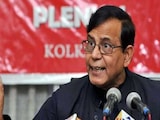New Delhi:
Prime Minister Narendra Modi chaired a meeting with key ministers and officials on agriculture and the rural economy on Friday evening discussing issues of the agrarian sector as a part of his review of various ministries.
Far from Delhi, 45-year-old Puran Singh, a marginal farmer in Madhya Pradesh looked skywards, seeking divine intervention in the hope that unlike last year his one bigha land won't be left thirsting for rain this time around. Last year he lost most of his Soya Bean crop, this year he's keeping his fingers crossed as the sole bread winner for his family for nine.
In another part of the country, 60-year-old Kashinath Mahato has prepared his 12 acres of land for the Kharif crop. He's lost the last two crop cycles to unseasonal rain and hailstorms and this Kharif season is critical. Mahato says, "We are afraid that due to sub normal monsoon not only this produce will be affected but the next crop as well." When asked if he has a backup plan, he's even more uncertain. "What can we do, I am not like others that I will commit suicide. We are dependent on nature, if government supports us, its fine otherwise what else can we do," he says with despair.
The prospect of a subnormal monsoon is nothing short of terrifying for farmers like Kashi and Puran Singh. Their anxiety has increased after the Met department said that the monsoon is likely to be below normal this year with north-west and central India likely to see a sub-normal rainfall.
The agriculture ministry has already prepared a contingency plan. Agriculture Minister Radha Mohan Singh told NDTV, "Contingency plan for 500 rain deficient district or drought probe districts is already in place. Subsidy will be given where necessary. We have already told state governments to prepare for sub normal rainfall."
This will be the new government's first big challenge. Inflation has shown a marginal improvement after a long time and a sub normal monsoon will have a direct impact on prices of essential commodities.
Far from Delhi, 45-year-old Puran Singh, a marginal farmer in Madhya Pradesh looked skywards, seeking divine intervention in the hope that unlike last year his one bigha land won't be left thirsting for rain this time around. Last year he lost most of his Soya Bean crop, this year he's keeping his fingers crossed as the sole bread winner for his family for nine.
In another part of the country, 60-year-old Kashinath Mahato has prepared his 12 acres of land for the Kharif crop. He's lost the last two crop cycles to unseasonal rain and hailstorms and this Kharif season is critical. Mahato says, "We are afraid that due to sub normal monsoon not only this produce will be affected but the next crop as well." When asked if he has a backup plan, he's even more uncertain. "What can we do, I am not like others that I will commit suicide. We are dependent on nature, if government supports us, its fine otherwise what else can we do," he says with despair.
The prospect of a subnormal monsoon is nothing short of terrifying for farmers like Kashi and Puran Singh. Their anxiety has increased after the Met department said that the monsoon is likely to be below normal this year with north-west and central India likely to see a sub-normal rainfall.
The agriculture ministry has already prepared a contingency plan. Agriculture Minister Radha Mohan Singh told NDTV, "Contingency plan for 500 rain deficient district or drought probe districts is already in place. Subsidy will be given where necessary. We have already told state governments to prepare for sub normal rainfall."
This will be the new government's first big challenge. Inflation has shown a marginal improvement after a long time and a sub normal monsoon will have a direct impact on prices of essential commodities.















